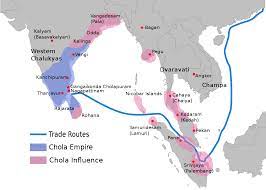The Chola dynasty was a powerful empire that ruled over southern India from the 9th to the 13th century. The Cholas were known for their military conquests, cultural achievements, and administrative skills. The dynasty’s reign saw the flourishing of trade, agriculture, and the arts, which had a profound impact on the region and beyond.

Table of Contents
Early History
The Chola Dynasty was founded by Vijayalaya Chola in 850 CE. He conquered the city of Thanjavur and established his capital there. His son, Aditya I, continued his father’s conquests and expanded the Chola Empire. Aditya I also built many temples and was a patron of the arts.
Rajendra Chola I and Conquests
Rajendra Chola I, son of Rajaraja Chola I, is considered the greatest ruler of the Chola Dynasty. He expanded the Chola Empire to include Sri Lanka, the Maldives, and parts of Southeast Asia. He also defeated the Western Chalukyas and the Pandyas, two powerful kingdoms of South India.
Rajendra Chola I was a great patron of the arts and built many temples, including the famous Brihadeeswarar Temple in Thanjavur. He also commissioned the construction of the Gangaikonda Cholapuram temple, which was larger than the Brihadeeswarar Temple.
Trade and Commerce
The Chola Dynasty was a great maritime power and had a flourishing trade and commerce network. They traded with countries like China, the Middle East, and Southeast Asia. The Cholas had a powerful navy and controlled the Indian Ocean trade routes.
The Cholas also had a well-developed agricultural system and were known for their irrigation techniques. They built many tanks and canals to irrigate their fields and increase agricultural productivity.
Art and Architecture
The Chola Dynasty was known for its great art and architecture. The temples built by the Cholas are some of the finest examples of South Indian temple architecture. The Brihadeeswarar Temple in Thanjavur, built by Rajaraja Chola I, is a UNESCO World Heritage site and is considered as one of the greatest achievements of Indian architecture.
The Cholas also patronized literature and the arts. Many great works of Tamil literature were written during the Chola period. The Cholas also encouraged dance and music, and the famous classical dance form, Bharatanatyam, originated in Tamil Nadu during this period.
Decline and Legacy of the Chola Dynasty
The decline of the Chola Dynasty began in the 12th century CE. The Pandya and Chera kingdoms of South India rose in power, and the Cholas were weakened by internal strife. The dynasty finally came to an end in the 13th century CE.
However, the legacy of the Chola Dynasty lives on. Their art, architecture, and literature continue to inspire people even today. The temples built by the Cholas are still important religious and cultural centers in South India. The Cholas also played a significant role in the development of Tamil Nadu as a center of culture and learning.
Conclusion
The Chola Dynasty was one of the greatest dynasties in Indian history. They were known for their conquests, trade and commerce, art and architecture, and patronage of literature and the arts. The Cholas had a significant impact on the culture and politics of South India and left a lasting legacy that continues to inspire people even today.
The Cholas were patrons of art and architecture, and their reign saw the construction of magnificent temples, such as the Brihadisvara Temple in Thanjavur and the Gangaikonda Cholapuram Temple. These temples are not only architectural marvels but also reflect the religious and cultural beliefs of the Chola people.
The Chola dynasty was also known for its maritime power and trade. The Cholas controlled the trade routes in the Bay of Bengal and established a strong navy to protect their trade interests. They also maintained diplomatic relations with other kingdoms and countries, including China and the Sri Vijaya empire in Southeast Asia.
Administration in the Chola Dynasty
The Chola administration was highly organized and efficient. The empire was divided into provinces, each governed by a local ruler. The Cholas introduced several reforms, such as the implementation of the village assemblies, which allowed for greater participation of the people in the administration of the kingdom.
Religion in the Chola Dynasty
The Chola dynasty was also famous for its contributions to religion and philosophy. The Cholas were great patrons of Hinduism and encouraged the spread of the religion throughout their empire. The Chola kings also supported the growth of the Bhakti movement, which emphasized devotion and personal relationships with the divine.
In conclusion, the Chola dynasty was one of the most powerful and influential empires in the history of ancient India. The Cholas’ contributions to art, architecture, trade, administration, religion, and philosophy continue to shape the culture and history of southern India even today.
Important Links